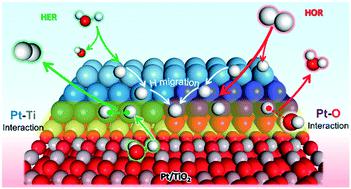当前位置:
X-MOL 学术
›
Catal. Sci. Technol.
›
论文详情
Our official English website, www.x-mol.net, welcomes your feedback! (Note: you will need to create a separate account there.)
Understanding the effect of interfacial interaction on metal/metal oxide electrocatalysts for hydrogen evolution and hydrogen oxidation reactions on the basis of first-principles calculations
Catalysis Science & Technology ( IF 5 ) Pub Date : 2020-06-30 , DOI: 10.1039/d0cy00960a Xingqun Zheng 1, 2, 3, 4, 5 , Li Li 1, 2, 3, 4, 5 , Mingming Deng 1, 2, 3, 4, 5 , Jing Li 1, 2, 3, 4, 5 , Wei Ding 1, 2, 3, 4, 5 , Yao Nie 6, 7, 8, 9, 10 , Zidong Wei 1, 2, 3, 4, 5
Catalysis Science & Technology ( IF 5 ) Pub Date : 2020-06-30 , DOI: 10.1039/d0cy00960a Xingqun Zheng 1, 2, 3, 4, 5 , Li Li 1, 2, 3, 4, 5 , Mingming Deng 1, 2, 3, 4, 5 , Jing Li 1, 2, 3, 4, 5 , Wei Ding 1, 2, 3, 4, 5 , Yao Nie 6, 7, 8, 9, 10 , Zidong Wei 1, 2, 3, 4, 5
Affiliation

|
Understanding the interfacial interaction between metals (M) and transition metal oxide (TMO) supports is essential for the material design of high performance electrocatalysts. In this study, we constructed Pt/TiO2 composite models with interfacial Pt–Ti and Pt–O bonds respectively, to clarify the interface effect on electronic structures, species adsorption/desorption and migration properties, and HER and HOR mechanisms through first-principles calculations. Interfacial Pt–Ti metallic interaction causes more delocalized electrons on the Pt cluster, which strengthens H and OH adsorption, facilitating *H migration and H2O dissociation. Meanwhile interfacial Pt–O covalent interaction affects the localized electronic structure of Pt with deficient electrons, which results in optimum H adsorption/desorption and complicated *H migration processes. The interface sites and non-interface sites jointly provide an efficient H migration channel and reaction pathway. For the HER, the Pt–O interaction benefits the Tafel step, and the Pt–Ti interaction is favorable for the Volmer step. For the HOR, the Pt–O interaction contributes to a higher HOR activity and anti-oxidation ability than Pt–Ti. These results can serve as theoretical guidance for constructing high performance M/TMO electrocatalysts for the HER/HOR by regulating the interfacial bond type and proportion.
中文翻译:

基于第一性原理计算,了解界面相互作用对金属/金属氧化物电催化剂上析氢和氢氧化反应的影响
了解金属(M)与过渡金属氧化物(TMO)载体之间的界面相互作用对于高性能电催化剂的材料设计至关重要。在这项研究中,我们构建了分别具有界面Pt–Ti和Pt–O键的Pt / TiO 2复合模型,以阐明通过第一原理对电子结构,物质吸附/解吸和迁移性质以及HER和HOR机理的界面效应。计算。界面上的Pt-Ti金属相互作用会在Pt团簇上引起更多的离域电子,从而增强H和OH的吸附,从而促进* H迁移和H 2O解离。同时,界面Pt-O共价相互作用会影响电子中缺乏电子的Pt的局部电子结构,从而导致最佳的H吸附/解吸和复杂的* H迁移过程。界面位点和非界面位点共同提供了有效的H迁移通道和反应途径。对于HER,Pt-O相互作用有利于Tafel步骤,而Pt-Ti相互作用有利于Volmer步骤。对于HOR,Pt-O相互作用比Pt-Ti具有更高的HOR活性和抗氧化能力。这些结果可通过调节界面键的类型和比例为构建HER / HOR的高性能M / TMO电催化剂提供理论指导。
更新日期:2020-07-21
中文翻译:

基于第一性原理计算,了解界面相互作用对金属/金属氧化物电催化剂上析氢和氢氧化反应的影响
了解金属(M)与过渡金属氧化物(TMO)载体之间的界面相互作用对于高性能电催化剂的材料设计至关重要。在这项研究中,我们构建了分别具有界面Pt–Ti和Pt–O键的Pt / TiO 2复合模型,以阐明通过第一原理对电子结构,物质吸附/解吸和迁移性质以及HER和HOR机理的界面效应。计算。界面上的Pt-Ti金属相互作用会在Pt团簇上引起更多的离域电子,从而增强H和OH的吸附,从而促进* H迁移和H 2O解离。同时,界面Pt-O共价相互作用会影响电子中缺乏电子的Pt的局部电子结构,从而导致最佳的H吸附/解吸和复杂的* H迁移过程。界面位点和非界面位点共同提供了有效的H迁移通道和反应途径。对于HER,Pt-O相互作用有利于Tafel步骤,而Pt-Ti相互作用有利于Volmer步骤。对于HOR,Pt-O相互作用比Pt-Ti具有更高的HOR活性和抗氧化能力。这些结果可通过调节界面键的类型和比例为构建HER / HOR的高性能M / TMO电催化剂提供理论指导。


























 京公网安备 11010802027423号
京公网安备 11010802027423号